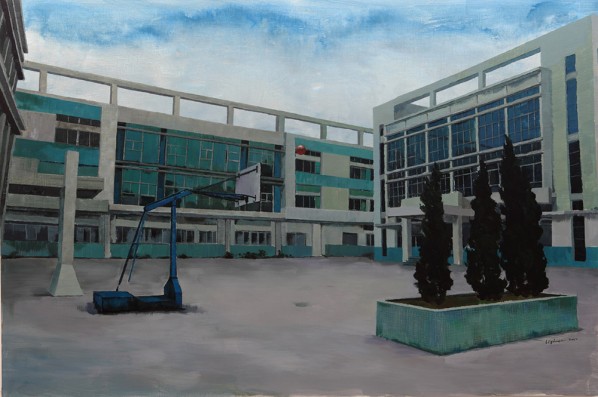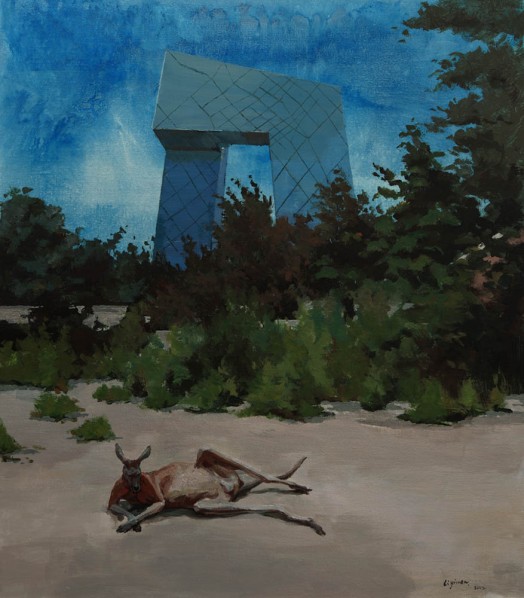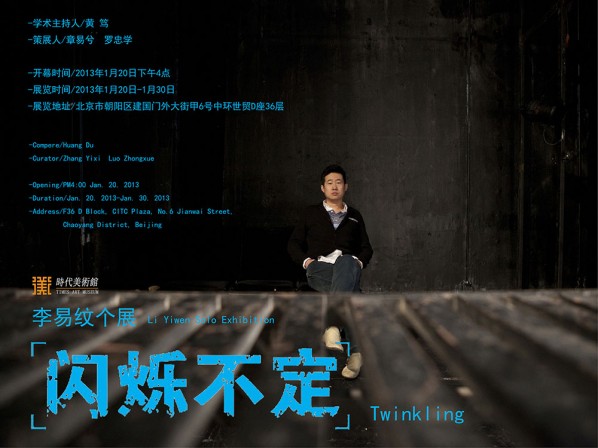Li Yiwen: The Painting of Psychological Displacement
By Huang Du
Li Yiwen’s paintings have a unique quality, one that makes palpable each thread and strand of their poetry. A pale ash grey mood; a quiet atmosphere; vast, empty spaces; cool, lonely architecture: they’re just like some past or present “no-man’s land.” These defamiliarized scenes starkly contrast with the ostentation and agitation of urban life. The reason Li Yiwen chose this painterly language of psychological“displacement” comes from when, in the course of painting, the artist discovered he was gradually approaching the depths of contemporary art. He reflected on academic art, especially on how academic painting stresses drawing from nature within a framework of realism. This is particularly true of the still overwhelmingly influential Soviet school of oil painting, which is not the true European realist tradition. He realized that he must break away from these limitations and find a painting style suitable to display his self—a style and language composed of purity, tranquility, poetry, and strangeness.

Li Yiwen, "A Lone Soul", 2012; acrylic on canvas, 200X300cm

Li Yiwen, "How to Disappear Completely", 2012; acrylic on canvas, 285X118cm
The aesthetic interest that Li Yiwen pursues in his painting is closely related to his personal artistic experience. He previously spent a long period reveling in the hazy world of ink painting and lingering in the beautiful tradition of calligraphy. Traditional arts inculcate a succinct, tranquil, poetic aesthetic spirit, which he then translated and blended into the language of oil painting. That is to say this was a natural process of integration, a course of subtle influence. Because of this, it’s hard to detect a sense of pretention in Li Yiwen’s paintings. Apart from this, whether they’re vast sceneries or microcosms, populated or empty, Li Yiwen employs postmodern methods in his forms. There’s a sense of distance, filtering, and sublimation to his images as well as a sense of appropriation, combination, and fusion. Especially those pictures into which he incorporates illogical, ironic, illusionary, disjoint and pulp fiction elements, they topple previous narratives of painting while also producing a new imagistic meaning—a perceptible, defamiliarized modality. In this way, imaginary space is continually opened and extended. In a sense, he has developed a rhetoric of painting. This unique artistic language seems to anticipate a new aesthetic of painting.

Li Yiwen, "Ideal Is Less than Desolation", 2012; acrylic on canvas, 150X170cm

Li Yiwen, "NO!", 2012; acrylic on canvas, 150X100cm
Looking at the situation of painting in China today (primarily composed of the academic style, the popular styles of big-name artists, and a new cartoonish style), Li Yiwen single-mindedly and earnestly researches and analyzes the relationship between the self and the other, history and reality, form and concept. He ultimately found a small crevice for painting among the many complicated artistic phenomena, a painterly language that can express his self-awareness. In his paintings, he maintains a balance, measuredly aloof, in control, meticulous without losing boldness, cautious without losing spontaneity.
Like many young people, Li Yiwen must face the grim and indifferent world, and he often will let out an exasperated sigh. This sense of helplessness saturates his paintings. Painting ultimately becomes a safe haven for his personal emotions.
2013/1/7 Beijing

Li Yiwen, "The Future That Could Not Be Directed", 2012; acrylic on canvas, 285X118cm&diam:120cm magnets, gold thread&needles
About the exhibition
Academic Director: Huang Du
Curator: Zhang YIxi, Luo Zhongxue
Opening: 16:00, January 20, 2013
Duration: January 20 through to Janary 30, 2013
Venue: Times Art Museum
Address: F 36 D Block, CITC Plaza, No. 6 Jianwai Street, Chaoyang District, Beijing
Courtesy of the artist and Times Art Museum.





























